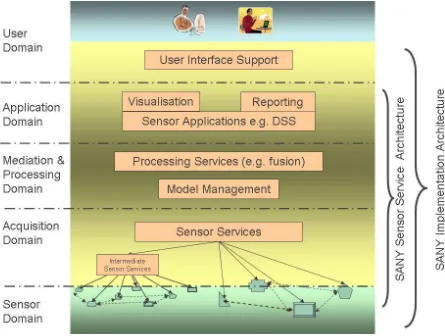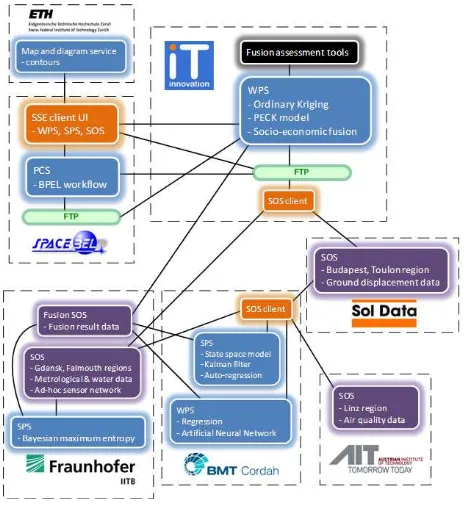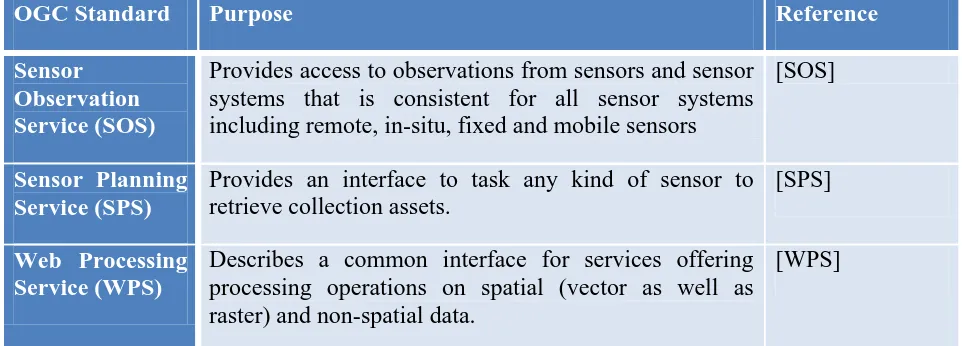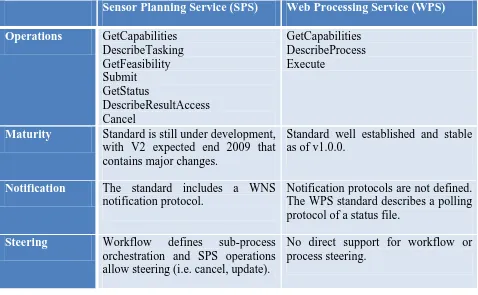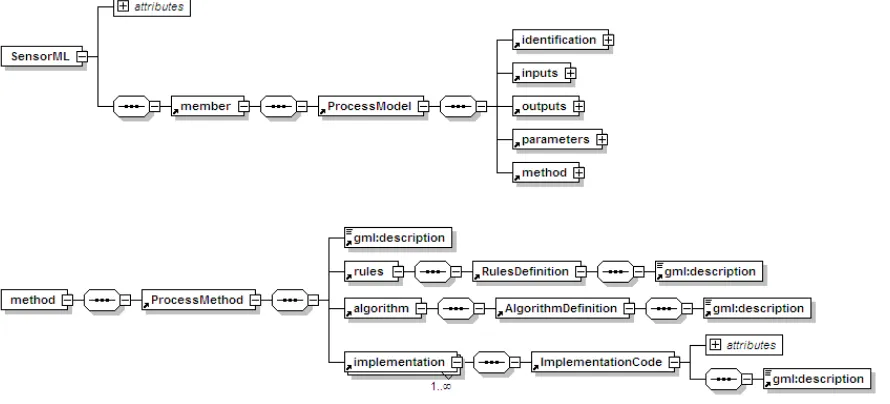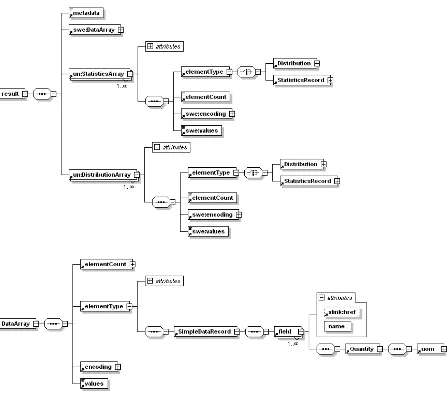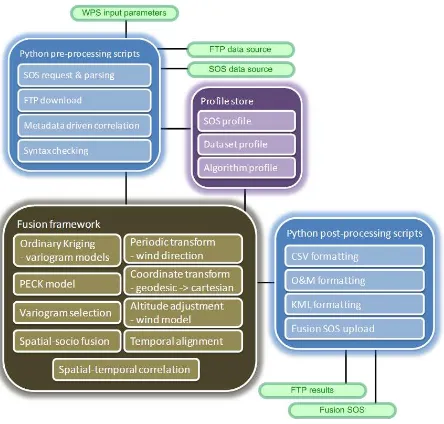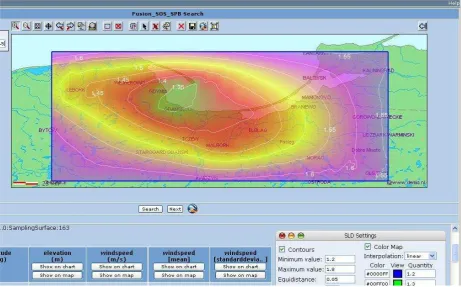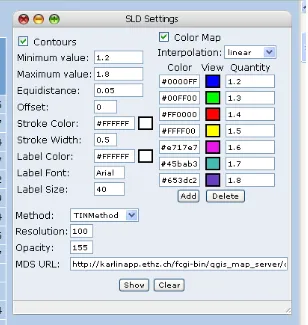Version: 1 (Rev 1.2)
Category: OGC
®Discussion Paper
Editor:
Stuart E. Middleton (Ed.)
SANY Fusion and Modelling Architecture
Copyright notice
See Copyright statement on page 10.
To obtain additional rights of use, visit http://www.opengeospatial.org/legal/.
Warning
This document is not an OGC Standard. It is distributed for review and comment. It is
subject to change without notice and may not be referred to as an OGC Standard.
Recipients of this document are invited to submit, with their comments, notification of
any relevant patent rights of which they are aware and to provide supporting
documentation.
Document type: Abstract Specification
Document subtype: OGC® Discussion Paper
Document stage: Approved
Sixth Framework Programme
Priority IST 2.5.12
Information Society Technologies
Integrated Project
Contract No.: 033564
Deliverable D3.3.2.3
Version 1.2
SANY Fusion and Modelling Architecture
Document Control Page
Title
SANY Fusion and Modelling Architecture
Creator
Stuart E. Middleton
Editor
Stuart E. Middleton
Description
This document reports the considered SANY best practice for
using OGC standards to provide generic fusion processing
services. Concrete case studies are documented and a
detailed appendix is provided with example of XML request
and responses.
Publisher
SANY Consortium
Contributors
Stuart E. Middleton, Galina Veres, Zlatko Zlatev, IT Innovation
Centre, University of Southampton, UK
[IT-INNOV]
Kym Watson, Ralf Bommersbach, Siegbert Kunz, Desiree
Hilbring, Fraunhofer-Institute IITB, Germany
[IITB]
Mark Lidstone, Tingting Shu, BMT Cordah, UK
[BMT]
Patrick Jacques, Spacebel, Belgium
[SPB]
Type
Text
Format
MS Word
Language
EN-GB
Creation date
20/03/2009
Version number
1.2
Version date
16/12/2009
Last modified by
Stuart E. Middleton
Rights
Copyright University of Southampton, Fraunhofer-Institute IITB,
BMT Cordah, Spacebel, 2009. Published under the terms of
the SANY contract.
Audience
internal
public
restricted, access granted to:
Review status
Draft
WP manager accepted
SP manager accepted
MB quality controlled
Coordinator accepted
Where applicable:
Accepted by the GA
Accepted by the GA
as public document
Action requested
to be revised by partners involved in the preparation of the
deliverable
to be revised by all SANY partners
for approval of the WP manager
for approval of the SP manager
for approval of the Quality Manager
for approval of the Project Coordinator
for approval of the General Assembly
Requested
deadline
Revision history
Version
Date
Modified by
Comments
Skeleton
20/03/2009
IT-INNOV
Skeleton for SP3 approval
0.1
20/05/2009
IT-INNOV
Initial draft
0.2
26/05/2009
IT-INNOV
IT-INNOV section 2 input
0.3
02/06/2009
IT-INNOV, BMT,
SPB, IITB
Collated input from BMT,
SPB and IITB plus
IT-INNOV edits
0.4
15/06/2009
IITB, BMT, IT-INNOV More collated inputs from
IITB, BMT, IT-INNOV
0.5
29/06/2009
IT-INNOV
Version with SP3 meet
comments cleaned up
1.0
06/07/2009
IITB, BMT, IT-INNOV SP3 release candidate
ready for partner review
1.0.1
20/08/2009
AIT
MB level QA
1.1
01/09/2009
IT-INNOV
Final versions created for
(1) reviewers (2) public
Table of Contents
1.
Introduction ... 11
1.1.
Purpose ... 12
1.2.
Intended audience ... 12
1.3.
Structure of document ... 12
1.4.
Abbreviations and Acronyms ... 13
2.
Services and information models for generic fusion ... 15
2.1.
Architectural context ... 15
2.2.
Service infrastructure ... 16
2.3.
OGC standards overview ... 18
2.4.
Use of OGC standards for generic processing ... 19
2.5.
Discovery of processing services ... 24
2.6.
Quality and irregular metadata ... 25
2.7.
Processing uncertainty ... 27
2.8.
Semantic annotation and the vocabulary problem ... 29
2.9.
Generic fusion algorithms ... 31
2.10.
Intelligent configuration and deployment of processing ... 32
2.11.
Visualization of coverage ... 33
3.
Architectural designs ... 36
3.1.
Service deployment ... 36
3.2.
Case study 1 - Fusion WPS design [IT-INNOV] ... 36
3.2.1
Architecture ... 36
3.2.2
Module definitions ... 39
3.2.3
Module interactions ... 41
3.3.
Case study 2 - Fusion WPS / SPS design [BMT] ... 43
3.3.1
Architecture ... 43
3.3.2
Module definitions ... 45
3.3.3
Module interactions ... 48
3.4.
Case study 3 - Fusion SOS / SPS design [IITB] ... 51
3.4.1
Architecture ... 51
3.4.2
Module definitions ... 55
3.4.3
Module interactions ... 57
3.5.
Algorithm development ... 62
3.5.1
Spatial algorithm: Kriging [IT-INNOV] ... 62
3.5.2
Spatial-social correlation: SP6 [IT-INNOV] ... 64
3.5.3
Spatial-temporal correlation: SP5 [IT-INNOV] ... 64
3.5.4
Domain model: PECK [IT-INNOV] ... 64
3.5.5
Spatial-temporal algorithm: Bayesian maximum entropy [IITB] ... 65
3.5.6
Temporal algorithm: Regression [BMT] ... 66
3.5.7
Temporal algorithm: Artificial Neural Network [BMT] ... 66
3.5.8
Temporal algorithm: Probability Index [BMT] ... 66
3.5.10
State space model algorithm: Kalman filter [BMT] ... 67
4.
Conclusions ... 68
5.
References ... 69
6.
Appendix A: I/O specification ... 71
6.1.
IT-INNOV I/O specification ... 71
6.1.1
IT-INNOV WPS GetCapabilities ... 71
6.1.2
IT-INNOV WPS DescribeProcess ... 74
6.1.3
IT-INNOV WPS Execute ... 83
6.1.4
IT-INNOV WPS Result set formats ... 93
6.2.
IITB I/O specification ... 103
6.2.1
IITB Fusion SOS GetCapabilities ... 103
6.2.2
IITB Fusion SOS DescribeSensor ... 110
6.2.3
IITB Fusion SOS GetObservationById ... 114
6.2.4
IITB Fusion SOS GetFeatureOfInterest ... 120
6.2.5
IITB SPS Fusion Process Description ... 122
6.2.6
IITB SPS GetCapabilities ... 126
6.2.7
IITB SPS DescribeTasking ... 131
6.2.8
IITB SPS GetFeasibility ... 135
6.2.9
IITB SPS Submit ... 139
6.2.10
IITB SPS GetStatus ... 142
6.2.11
IITB SPS DescribeResultAccess ... 143
6.2.12
IITB SPS Cancel ... 144
6.3.
BMT I/O specification ... 145
6.3.1
BMT WPS GetCapabilities ... 145
6.3.2
BMT WPS DescribeProcess ... 145
6.3.3
BMT WPS Execute ... 150
6.3.4
BMT SPS GetCapabilities ... 154
6.3.5
BMT SPS DescribeTasking ... 155
6.3.6
BMT SPS Submit ... 156
6.3.7
BMT SPS GetStatus ... 157
6.3.8
BMT SPS DescribeResultAccess ... 157
List of Figures
Figure 2.1. Functional Domains of the SensorSA ... 16
Figure 2.2. SANY processing service data flow ... 17
Figure 2.3. SensorML schema ... 22
Figure 2.4. SamplingSurface schema ... 23
Figure 2.5. ObservationCollection schema ... 23
Figure 2.6.SWE metadata schema ... 24
Figure 2.7. SWE result schema ... 28
Figure 2.8. Observation schema ... 29
Figure 2.9. Generic fusion design: IT-INNOV case study ... 32
Figure 2.10. Display of Contours ... 34
Figure 2.11. Styled Layer Descriptor (SLD) Configuration ... 35
Figure 2.12. KML visualization of a kriging spatial result set ... 36
Figure 3.1. Deployment of the IT-INNOV Fusion WPS and support modules ... 37
Figure 3.2. WPS module interface ... 39
Figure 3.3. WPS process discovery sequence ... 41
Figure 3.4. WPS process execution sequence ... 43
Figure 3.5. Modules in the BMT architecture ... 44
Figure 3.6. BMT WPS module interface ... 45
Figure 3.7. BMT SPS module interface ... 47
Figure 3.8. BMT SOS client module interface ... 48
Figure 3.9. Basic catalogue interaction ... 48
Figure 3.10. Basic WPS execute interactions ... 49
Figure 3.11. WPS execute interactions with SOS data retrieval ... 50
Figure 3.12. Interaction with IT-INNOV fusion data services ... 51
Figure 3.13. Component diagram of Fusion SPS/SOS architecture ... 54
Figure 3.14. General information workflow of IITB Fusion approach ... 57
Figure 3.15. Message exchange pattern Fusion SOS/SPS ... 59
List of Tables
Table 2.1. Overview of the OGC Standards used for the processing and support ... 19
Table 2.2. Comparison of WPS and SPS standards ... 21
Table 3.1. BMT SPS operation support matrix ... 47
Table 3.2. Summary of Fusion SOS/SPS concepts ... 53
Table 3.3. IITB SOS operation support matrix ... 55
List of SANY Best Practice
Value proposition: Data fusion ... 15
Value proposition: Generic fusion ... 15
SANY Best Practice: Choice of processing service standard ... 21
SANY Best Practice: Usage of OGC SWE standards for processing services ... 24
SANY Best Practice: Usage of application schema for meta-information for discovery . 25
SANY Best Practice: Quality metadata information encoded in SensorML ... 26
SANY Best Practice: Metadata flags for irregular data of the fusion result ... 27
SANY Best Practice: Domain ontology linkage ... 30
SANY Best Practice: URN mapping between domains ... 30
SANY Best Practice: URN definition ... 30
Copyright University of Southampton, Fraunhofer-Institute IITB, BMT Cordah, Spacebel, 2009.
Published under the terms of the SANY contract.
The authors grant third parties the right to use and distribute all or parts of this document, provided that the SANY project and the document are properly referenced.
THIS DOCUMENT IS PROVIDED BY THE COPYRIGHT HOLDERS AND CONTRIBUTORS "AS IS" AND ANY EXPRESS OR IMPLIED WARRANTIES, INCLUDING, BUT NOT LIMITED TO, THE IMPLIED WARRANTIES OF MERCHANTABILITY AND FITNESS FOR A
PARTICULAR PURPOSE ARE DISCLAIMED. IN NO EVENT SHALL THE COPYRIGHT OWNER OR CONTRIBUTORS BE LIABLE FOR ANY DIRECT, INDIRECT, INCIDENTAL, SPECIAL, EXEMPLARY, OR CONSEQUENTIAL DAMAGES (INCLUDING, BUT NOT LIMITED TO, PROCUREMENT OF SUBSTITUTE GOODS OR SERVICES; LOSS OF USE, DATA, OR PROFITS; OR BUSINESS INTERRUPTION) HOWEVER CAUSED AND ON ANY THEORY OF LIABILITY, WHETHER IN CONTRACT, STRICT LIABILITY, OR TORT (INCLUDING
1.
Introduction
The SANY project has a high level objective to
develop fusion services that allow environmental
risk applications to combine available information into comprehensive knowledge about the
problem in hand
. We have broken down this objective [D3.3.1.3] into several concrete
sub-objectives, the combination of which we hope fulfils this high level objective:
Generic algorithm design contributing towards a Generic Fusion and Modelling engine
(GFME) concept
Fusion capabilities integrated into the SANY service environment
Propagation of sensor uncertainty information throughout algorithmic processing
Support for ad-hoc and mobile sensor information sources
Concrete algorithm implementations as case studies applied to available datasets
Data fusion and modelling is an effective way to add value to existing datasets of sensor
measurements. This can be achieved via aggregation of datasets or inference of new data from
relationships and patterns within existing datasets. Generic fusion provisions data fusion in a
way that separates configuration and data from the algorithmic processing itself, allowing re-use
of algorithms and pre/post-processing between datasets. Re-use of algorithms and techniques
lowers the cost of development, configuration and deployment of fusion services.
SANY fusion services use the OGC service infrastructure, and in particular the SWE standard set
for all communication with end-users. Support for such standards allows our processing work to
be more easily integrated both now and in the future with other third party services, either
hosting new datasets or new processing capabilities.
The metadata provided as part of the SWE standards has allowed us to make progress towards
the goal of supporting ad-hoc and mobile sensors through support for an automated 'plug and
play' dataset capability. Once processing services can automatically self-configure to the data
they are processing, the resulting sensor network processing capability become agile and robust
in response to network changes.
Through our concrete case studies we have made significant progress in the representation,
sharing and processing of sensor accuracy associated with each of our measurement datasets.
Each SANY service that provides a dataset also provides uncertainty metadata, such as the
sensor precision values for each measurement device, which processing services can choose to
propagate through algorithmic processing. Processing service result sets are also generated with
uncertainty metadata, detailing for each result associated variances, standard deviations etc. This
representation and use of uncertainty helps us improve accuracy when generating results and
make better interpretations when analysing results for decision support.
As a final achievement we have decided to compile and share our considered view of 'SANY
best practice' when implementing or using processing services in the context of an OGC service
infrastructure. Each best practice recommendation is made from the experience gained within the
SANY project and it is hoped that this will guide other processing service / application users in
their future work. Concrete examples can also be found in the appendix section to provide
grounded exemplars for our recommendations.
1.1.
Purpose
This document is part of the SP3 fusion and modelling design activity. The deliverable D3.3.2.3
represents the final year (V2) design. The purpose of this document is to identify SANY best
practice and case study designs developed within SANY.
1.2.
Intended audience
This document will be released as a public statement of best practice, from the SANY
consortium, regarding how best to design fusion and modelling services using the OGC SWE
standard set. The audience is expected to be of a technical nature, consisting of people who are
considering using the OGC standards.
1.3.
Structure of document
In section 2 we outline the considered SANY best practice, both for using OGC SWE standards
for developing processing services and for developing generic fusion approaches that can
process sensor accuracy and uncertainty introduced by algorithmic processing.
In section 3 we document the architectural designs from IT-INNOV, IITB and BMT, providing
concrete case studies for how processing services can be developed.
In section 4 we draw conclusions.
1.4.
Abbreviations and Acronyms
52N
Vendor of an open source implementation of OGC SWE services
ANN
Artificial Neural Network
ASAR
Advanced Synthetic Aperture Radar
ASMI
SANY Application Schema for Meta-information
BPEL
Business Process Execution Language
CLIPS
C Language Integrated Production System
CSV
Comma Separated Values
DLL
Dynamic Link Library
DSS
Decision Support System
ENVISAT
European Space Agency satellite
EO
Earth Observation
FTP
File Transfer Protocol
GFME
Generic Fusion and Modelling Engine
GML
Geography Markup Language
GPS
Global Positioning System
HTTP
Hyper-Text Transfer Protocol
IPTA
Interferometric Point Target Analysis
KML
Keyhole Markup Language
MAPE
Mean Absolute Percentage Error
MDS
Map and Diagram Service
MSE
Mean Square Error
NOAA
National Oceanic and Atmospheric Administration
O&M
Observation & Measurement model
OGC
Open Geospatial Consortium
OWL
Web Ontology Language
PCS
Processing Chain Service
PT
Point Target
SANY
Sensors ANYwhere integrated project
SensorML
Sensor Model Language
SensorSA
SANY Sensor Service Architecture
SLD
Styled Layer Descriptor
SOAP
Simple Object Access Protocol
SOS
Sensor Observation Service
SP<X>
SANY Sub Project
SPS
Sensor Planning Service
SWE
Sensor Web Enablement
UCUM
Unified Code for Units of Measure
UI
User Interface
UncertML
Uncertainty Markup Language
URL
Uniform Resource Locator
URN
Uniform Resource Name
WFS
Web Feature Service
WGS
World Geodetic System
WMS
Web Map Service
WPS
Web Processing Service
WSDL
Web Services Description Language
XML
Extensible Markup Language
2.
Services and information models for generic fusion
Data fusion and modelling is an effective way to add value to existing datasets of sensor
measurements. Aggregating multiple datasets within a common frame of reference (e.g. a single
spatial region) provides context for decision support. Domain relationships can be used to infer
new data from aggregated existing data. Data driven interpolation and prediction techniques can
discover and use patterns within existing datasets to provide information at interesting points in
space or time.
Value proposition: Data fusion
Data fusion and models add value to existing datasets. This is achieved through aggregation and
correlation of data within a common frame of reference and the use of data-driven interpolation,
prediction and inference techniques.
Generic data fusion techniques separate configuration and data from the algorithmic processing
itself. Dynamic configuration allows the re-use of existing algorithms for different datasets.
Metadata associated with existing datasets allows the automation of pre-processing and
post-processing, and the ability to plug and play datasets. Use of knowledge-based techniques allows
the semi-automation of the fusion assessment process.
Value proposition: Generic fusion
Generic fusion lowers the cost of data fusion. This is achieved through re-use of existing
algorithms, dynamic adaption of pre-processing to datasets and semi-automated fusion
assessment.
2.1.
Architectural context
Figure 2.1. Functional Domains of the SensorSA
This domain mediates between the Application Domain and the underlying information sources
in the Acquisition Domain, whereby the domains should not be understood as a strict layered
architecture. The Mediation & Processing Domain provides generic or thematic processing
capabilities such as fusion of information (from sensors and other information sources),
management of models or access to model results. In addition, service support for the discovery
of sensors, data and services, naming resolution or service chaining are grouped in the Mediation
& Processing Domain. The support for processing chains is described in D2.3.3 section 10.9.
2.2.
Service infrastructure
Figure 2.2. SANY processing service data flow
We have chosen to support both the OGC Web Processing Service (WPS) and Sensor Planning
Service (SPS) standards when writing our processing services. Each standard has different
strengths and weaknesses (see section 2.4) and in SANY we wanted to see how they would both
perform.
When a processing service (WPS or SPS) needs data it will use a SOS client to issue a SOS
request and parse the SOS response. The parsed XML response data will either be used directly
or saved in an intermediate result format such as comma separated variable (CSV). In addition to
extracting the raw sensor measurements from the SOS responses the associated metadata (units,
sensor accuracy etc) is also extracted and made available to use by the processing service. Where
the FTP site is used the cached SOS response XML is provided, allowing the SOS client to skip
the SOS request stage. Multiple input sources are possible and the processing service must in
these cases pre-process the sensor data from each input source, aggregate it together and do the
syntax checking (etc) as required prior to algorithmic processing.
To achieve high accuracy / performance fusion algorithms must normally be heavily tailored to
the dataset they are working on. In SANY we have separated configuration and data from the
algorithms themselves, allowing a number of generic fusion algorithms to be created than can
run on a dynamically assigned dataset. Each dataset undergoes a fusion assessment to create a
dataset specific configuration file. At runtime the fusion configuration (or 'profile') can be
selected along with the dataset. A fusion assessment tool will be created by IT-INNOV to
semi-automate this assessment process, allowing dataset owners to prototype fusion algorithms on the
fly prior to a fusion expert finishing the job.
After algorithmic processing a number of result formats will be created and made available
immediately via a FTP site. In addition, O&M results will be uploaded to a Fusion SOS for
longer term storage in a OGC SWE compatible format. Using an SOS to store fusion results
allows SANY to treat fusion processes as just another sensor service, making interoperability
with third party services and the creation of processing chains easier.
A Service Support Environment (SSE) client has been created for each of the SANY services
(WPS, SPS, SOS). This offers a simple user interface to provide the input parameters needed to
run fusion processes. When result sets are generated the SSE client visualizes them using
geospatial maps over which is rendered a contoured colour map and a representation of the result
set shape; the Map and Diagram Service (MDS) is used to achieve this.
2.3.
OGC standards overview
OGC Standard
Purpose
Reference
Sensor
Observation
Service (SOS)
Provides access to observations from sensors and sensor
systems that is consistent for all sensor systems
including remote, in-situ, fixed and mobile sensors
[SOS]
Describes a common interface for services offering
processing operations on spatial (vector as well as
raster) and non-spatial data.
[WPS]
Table 2.1. Overview of the OGC Standards used for the processing and support
The SensorSA basically adopts the specification of the Observations and Measurements (O&M)
model as defined in [O&M Part 1]. This information model is of core relevance for the access
and interpretation of the data provided through the Sensor Observation Service. It defines an
observation
as “an act associated with a discrete time instant or period through which a number,
term or other symbol is assigned to a phenomeno
n”.
The phenomenon is a
property
of an identifiable object, which is the
feature of interest
of the
observation. The observation uses a
procedure
, which is often an instrument or sensor but may
be a process chain, human observer, algorithm, computation or simulator. The key idea is that
the observation
result
is an estimate of the value of some property of the feature of interest, and
the other observation properties provide context or meta-information to support evaluation,
interpretation and use of the result.
The SensorSA uses the schema defined by the OGC Sensor Model Language (SensorML)
specification [SensorML] for the description of measurement processes.
In SensorSA data arises not only from sensor measurements and observations, but also from data
processing with specific services, e.g. a fusion or kriging algorithm to generate a spatial coverage
from a set of measurement points, or a time series analysis to produce a temporal interpolation.
The results of such data processing steps are themselves uncertain, on the one hand due to the
uncertainty of the input data, on the other hand due to the probabilistic or approximate nature of
the processing itself. Within the SensorSA, the uncertainty of data sets is described using the
descriptive model language UncertML, which was developed within the INTAMAP project
[INTAMAP].
2.4.
Use of OGC standards for generic processing
Generic processing
by the client. Finally the result set output data must be stored somewhere so the client can access
it, either in a service or remote file store.
In SANY we make heavy use of the OGC and OASIS standards for our processing and support
services. Datasets are stored and accessed via Sensor Observation Services (SOS) and FTP sites.
Processing is performed by Web Processing Services (WPS) and Sensor Planning Services
(SPS). Notification of progress and results is achieved using Web Notification Services (WNS)
and WS-Notification compliant protocols. This section provides an overview of how and why we
use these services.
Pre-processing: Input data from SOS
The task of fusion process is to create a new fusion result for an observed property
P
in a time
interval
T
and a set of sampling points
S
(e.g. a rectified grid) by applying a fusion algorithm
to
raw data from available SOS servers. The fusion processing procedure applies the O&M
GetObservation operation to each SOS server to obtain the available observations of the desired
property. Each available SOS server delivers the requested observations of one or multiple
observed properties
P
according to the time interval
T
and within a given geographical area
encoded by a Bounding Box. Duplicates are recognized as observations taken by the same
procedure (sensor) at the same sampling time; duplicates are deleted from the observation
collection.
The fusion processing procedure takes the inaccuracy of the raw sensor data into account. The
accuracy metadata should be in the observation result but could be located in SensorML if
applicable to all observations by that sensor.
The descriptive model language UncertML developed by the INTAMAP project [INTAMAP] is
used to encode the accuracy information into the XML file containing the result of the
observation collection (see sections 2.6 and 2.7).
Processing: Running algorithm(s) via SPS & WPS
In SANY we have both Sensor Planning Services for fusion processing (WebGenesis-based
Fusion SPS) and Web Processing Services. Our processing services act as clients to several
Sensor Observation Services (52°North SOS for source data, WebGenesis-based Fusion SOS for
storage of fusion results and SOAP protocol (SolData) SOS). We also make use of FTP input for
cached SOS responses which allows processing chains to be operated via a Processing Chain
Service (PCS).
Sensor Planning Service (SPS)
Web Processing Service (WPS)
Maturity
Standard is still under development,
with V2 expected end 2009 that
contains major changes.
Standard well established and stable
as of v1.0.0.
Notification
The standard includes a WNS
notification protocol.
Notification protocols are not defined.
The WPS standard describes a polling
protocol of a status file.
Steering
Workflow
defines
sub-process
orchestration and SPS operations
allow steering (i.e. cancel, update).
No direct support for workflow or
process steering.
Table 2.2. Comparison of WPS and SPS standards
SANY Best Practice: Choice of processing service standard
The WPS standard is somewhat lightweight, being very flexible in what it can do at the expense
of clients who will have to support each provider-specific implementation. The SPS standard
defines notification and steering protocols and is thus a good choice if this is important. Both
standards are easily extended and can support, for example, uncertainty and provenance
metadata as we have demonstrated in SANY via UncertML and SensorML descriptors.
Post-processing and storage: Output data from PCS, WPS, SPS, Fusion SOS
Figure 2.3. SensorML schema
Figure 2.4. SamplingSurface schema
As with the SamplingSurface and SensorML described above, the O&M observation also fulfils
two roles in the fusion workflow, one for input and one for output. O&M observations,
aggregated together in an O&M ObservationCollection if required, serve as input data for the
fusion process containing the “source” sensor data that shall be processed. The fusion result is a
so-called coverage, a function defined on a space-time grid of sampling points. This coverage is
encoded in the result section of an O&M observation using SWE common.
Figure 2.5. ObservationCollection schema
encode the uncertainty of both sensor input data (accuracy) and fusion results (statistical error).
(see below and section 2.6 and 2.7).
Figure 2.6.SWE metadata schema
SANY Best Practice: Usage of OGC SWE standards for processing services
Format fusion result sets using the SWE standards for easy reuse in a SWE compliant sensor
architecture. Use O&M part 1 (ObservationCollection) standard to format fusion results, along
with SWE common, with xlink:href links to UncertML (StatisticsArray, DistributionArray) to
store uncertainty information. Dataset specific quality flags can be defined in the om:metadata
section. Use SensorML (Process) standard to record both post-processing provenance
information and discovery information about what each processing service can offer. Use O&M
part 2 (SamplingSurface) standard to describe spatial regions, both as an input parameter and to
describe the final result sets.
2.5.
Discovery of processing services
Discovery of available SOS source data shall be enabled through a SANY Catalogue service.
The fusion process queries the Semantic Catalogue for SOS servers with observations of the
desired property in a given time interval and in the area of a bounding box around the sampling
point set. In addition, clients of processing services can use the Catalogue to query suitable
algorithms and WPS / SPS servers.
To ease the discovery of sensor related resources the SANY Application Schema for
Meta-information (ASMI) has been specified. Besides conventional resource types like services and
data it defines additional meta-information resource types related to the Observation &
Measurement Model:
Feature of interests can be described with the resource type MI_Data_FeatureOfInterest
Observable
properties
can
be
described
with
the
resource
type
MI_Data_ObservedProperty
Sensors or workflows can be described with the resource type MI_Data_Procedure. This
resource type contains a section to include SensorML data.
All meta-information needed for the creation of ASMI documents are available via the SOS
operation DescribeSensor and SOS/SPS operation GetCapabilities. Therefore it is possible to
create components automatically harvesting SOS instances for the creation of feature of interest,
observable properties, procedures and service resources types or SPS instances for the creation
of procedures and service resource types.
Once the meta-information is included in the catalogue users can discover it searching the
cat
alogue with the means of specific durables. “DatasetType” and “ServiceType” can be used to
discover resources according to their resource or service types. “FeatureOfInterestType”,
“ObservedPropertyType” and “ProcedureType” can be used to identify specific
feature of
interests, observable properties, sensors or WPS process or SPS task. A broader search can be
performed via “AnyText”, which realizes a full text search. All results contain a link to the
service, the discovered meta-information was derived from. Therefore the search for specific
feature of interests, observable properties and procedures can lead to SWE services accessing
theses resources.
The WPS v1.0.0 specification also supports application profiles where a DescribeProcess
response can return an URN to an OGC recognized profile. This profile allows a human readable
document and WSDL document to be associated with a well known WPS process. However our
use of the SANY catalogue service goes one step further associating machine readable SWE
metadata to the WPS process, using a SensorML document provided by the WPS and harvested
automatically by the catalogue service.
SANY Best Practice: Usage of application schema for meta-information for discovery
For the discovery of a sensor, WPS process or SPS task a meta-information schema reflecting
specific requirements is needed. The SANY Application Schema for Meta-information (ASMI)
can serve as an example supporting these requirements. It eases the discovery of observations
according to their observable properties, features of interest and procedures (sensors, processes
or tasks).
2.6.
Quality and irregular metadata
The O&M observation includes additional metadata for interpretation of the data and include
xlink:href links to blocks of UncertML embedded within the result block of the O&M
observation to define the uncertainty of both sensor input data (accuracy) and fusion results
(statistical error).
The fusion processing procedure takes the inaccuracy of the raw sensor data into account. It
determines the accuracy of the measurements. So the fusion task executes a
DescribeSensor
operation at the relevant SOS server to acquire this information. The accuracy metadata should
be in the observation result but could be located in SensorML if applicable to all observations by
that sensor.
SANY Best Practice: Quality metadata information encoded in SensorML
In the case of the IITB testbed, this meta-information is encoded in the SensorML of the related
procedure (sensor). An example fragment of a SensorML is below:
<sml:characteristics> <swe:DataRecord
definition="urn:ogc:def:property:OGC:1.0.1:physicalProperties"> <swe:field name="measurementProperties">
<swe:DataRecord
definition="urn:ogc:def:property:OGC:1.0.1:measurementProperties"> <swe:field name="Temperature accuracy"
xlink:href="urn:ogc:def:property:OGC:1.0.1:temperature"> <swe:QuantityRange
definition="urn:ogc:def:property:OGC:1.0.1:absoluteAccuracy"> <swe:uom code="Cel"/>
<swe:value>-0.5 0.5</swe:value> </swe:QuantityRange>
</swe:field> </swe:DataRecord> </swe:field> </swe:DataRecord> </sml:characteristics>
SANY Best Practice: Metadata flags for irregular data of the fusion result
In the case of the IITB testbed, the fusion result data section may also contain further quality
metadata as a quality flag. An example fragment of XML is below:
<om:Observation> …
<om:procedure xlink:href="urn:ogc:def:featureType:OGC:1.0.1:Process:201"/> <om:observedProperty
xlink:href="urn:ogc:def:property:OGC:1.0.1:temperature"/> …
<om:metadata>
<swe:elementType name="QualityFlag"
href="http://sanyv1.iitb.fraunhofer.de/Testbedgloss.htm#QualityFlags"> <swe:field name="Not a Number">
<swe:Text definition="Data matches a Not-A-Number value from the provider (or error code from an instrument)"/>
<swe:value>NaN</swe:value> </swe:field>
<swe:field name="Null">
<swe:Text definition="Data missing or null"/> <swe:value>NULL</swe:value>
</swe:field>
<swe:field name="out of engineering range">
<swe:Text definition="Data exceeds range specified for instrument"/> <swe:value>OOER</swe:value>
</swe:field>
<swe:field name="out of range for datatype">
<swe:Text definition="Data is out of valid range for this datatype"/> <swe:value>OODTR</swe:value>
</swe:field>
<swe:field name="out of calculation range">
<swe:Text definition="Data exceeds range that its calculation allows"/> <swe:value>OOCR</swe:value>
</swe:field>
2.7.
Processing uncertainty
There is a need to represent uncertainty information associated with the sensor input data and
fusion processing result data. In SANY our sensor datasets have sensor accuracy information
available and all of our algorithms can provide some sort of statistical error information along
with the result sets that are generated.
Sensor accuracy information is represented in SANY in terms of accuracy intervals that may or
may not be time variant based on the age of the sensor. Often the quality of the accuracy
information is based on the level of knowledge about the original sensor measurement campaign
that produced the dataset in the first place.
The result sets of our fusion processing services are both temporal and spatial (sometimes both)
and come with details about the estimation errors associated with each result. For spatial
algorithms we typically generate variance information associated with a result grid, or a
probability distribution. For temporal algorithms standard deviation is reported as the measure of
uncertainty of the results, with the same unit as the original data.
The SPS and WPS services within SANY provide UncertML blocks embedded within O&M
result blocks to define the associated statistical data that comes with the result sets. Standard
deviations / variances are represented using a un:StatisticsArray. More complex probability
distributions are represented using a un:DistributionArray. In both cases the raw data references
the associated UncertML data via xlink:href links in the om:result block. The schema diagram
below shows the XML structure we use, and a XML example can be found in sections 6.1.4 and
6.2.3.
Figure 2.7. SWE result schema
found in the appendix 6.1.4 and 6.2.3. Another issue exists with UncertML regarding the linkage
of a statistics array to a distribution array; xlink:ref is not currently supported so we have
overloaded the attribute definition for now. SANY has engaged directly with the OGC about this
and we expect the coming SWE v2 will be fully aligned with UncertML and vice versa.
2.8.
Semantic annotation and the vocabulary problem
One of the problems when aggregating datasets from different data sources is how to deal with
the different ways each data source labels identical, or sometimes very similar, concepts. This
semantic annotation problem can occur at a number of different levels. Within a single dataset
there can be inconsistent labelling (e.g. 'wspeed' ,'windspeed', 'ws') for the same concept as well
as inconsistent use of units (e.g. 'm', 'cm', 'mm'). When dealing with datasets from two separate
domains it is common to find that each domain has different labels for similar concepts (e.g.
'Temp', 'Temperature'), uses different units and scales ('
oC', '
oF') and properties that are similar,
but not identical (e.g. 'longitude' & 'latitude' using different reference frames such as WGS84 &
ETRS89).
In order to overcome these problems in SANY we have developed best practice suggestions for
naming URN's in SANY and mapping O&M result data concepts to a unique ontological
concept. Universal unit conversion is a very large problem and we suggest adopting a scalable
incremental support strategy. In SANY we use Unified Code for Units of Measure (UCUM) as
does SWE common.
Vocabulary mapping problem
There are two use cases for the vocabulary pseudonym mapping problem. The first is multiple
labels for a concept in the same dataset. The second is two independent datasets defining
different labels for the same concept.
In SANY we have looked at options available in the OGC schema and concluded that adding in
xlink:role attributes for observed properties is the preferred to identify per property which
ontological concept is being referenced. An example structure can be seen below.
SANY Best Practice: Domain ontology linkage
Observed properties reported by an SOS should be annotated using the xlink:role attribute with a
URL to the associated concept in the domain ontology. This then uniquely identifies the concept
and allows a client to resolve any vocabulary pseudonym problems.
Where two SOS's refer to the same concept using different domain specific ontologies we
recommend using a mapping function, provided by the party interested in aggregating these
datasets. Many ontology mapping techniques are available in the literature, each suitable for
different problem areas, so we only define a protocol for access to this function and do not define
the mapping function itself.
SANY Best Practice: URN mapping between domains
Where identical concepts from two datasets must be mapped together a semantic mapping
function is recommended. In SANY we suggest the follows the function protocol:
<target URN> MapURN( <source URN>,<source ontology URL>,<target ontology URL> )
<source URN> = URN to a concept in source ontology
<source ontology URL> = URL to source ontology (e.g. OWL file) <target ontology URL> = URL to target ontology (e.g. OWL file) <target URN> = URN to a concept in target ontology
We have also defined a URN definition policy within SANY for all URN's created to describe
our datasets.
SANY Best Practice: URN definition
Dataset labels should follow a URN definition policy that is compatible with the OGC
suggestions [RFC 5165]. Resources that are defined for the purpose of SANY applications
follow a naming scheme
urn:ogc:def:objectType:authority[:version] :code
.
Examples are below:
urn:ogc:def:data:SANY:2009.05:temperature
urn:ogc:def:statistic:SANY:2009.05:standard-deviation
Unit conversion problem
2.9.
Generic fusion algorithms
SANY Best Practice: Generic fusion
In SANY we define the idea of generic fusion as the separation of configuration and data from
the algorithmic processing; this allows the development of configurable algorithms that can be
re-used on a number of different datasets.
Generic fusion adds value by reducing the overall cost of processing service development via
reuse of existing algorithms.
The degree to which each SANY algorithm is generic varies depending on the needs of the
application it is supporting. Both the BMT and IITB algorithm sets support soft configuration but
are not designed to be configured dynamically at runtime. The IT-INNOV algorithms are hosted
within a WPS framework that provides live pre-processing support for profiling of the input data
source (FTP, SOS), dataset (offering within an SOS) and dataset specific algorithm parameters.
Generic fusion: IT-INNOV WPS case study
The IT-INNOV WPS infrastructure supports generic fusion at two levels (see figure 2.9). First a
set of Python scripts provides metadata driven pre-processing and post-processing. Second a
fusion framework provides configurable plug and play (via DLL's) support for new algorithms,
conversions (e.g. units) and transformations (e.g. coordinates).
The pre and post-processing Python scripts provide metadata driven self-configuration based on
the dynamically selected data source SOS/FTP and dataset provided by that data source. Each
fusion observed target property (e.g. 'windspeed') is selected at runtime and the O&M metadata
obtained from each SOS/FTP data source is used to identify the correct sensor value, associated
unit(s) and sensor accuracy information. Syntax checking is driven from the unit metadata
provided. Post-processing scripts use the metadata provided in the input (e.g. using the same
units) when generating both CSV and O&M formatted result sets.
The Python scripts themselves are designed to be either top level master scripts or generic
sub-scripts. The top level master scripts are formulaic in design and can be automatically generated
to semi-automate fusion deployment.
Figure 2.9. Generic fusion design: IT-INNOV case study
In SANY this fusion framework is our 'low-level' approach to the objective of a Generic Fusion
and Modelling engine (GFME). The 'high-level' approach can be seen by the use of WPS and
SPS standard services. The two approaches together provide a powerful approach to developing
a generic fusion capability that can provide processing capabilities to a variety of OGC-enabled
web services.
2.10. Intelligent configuration and deployment of processing
In SANY we have analysed the fusion assessment and offline setup process and tried to model
some of the knowledge and expertise required for the algorithms we have developed. To help the
offline processes of SOS, dataset and algorithm profile setup domain specific tools are required
that can elicit expert knowledge about the domain and perform analysis tasks on datasets that
will be available. To help the online process metadata driven pre-processing can be used in
combination with dataset profiles to reduce the amount of manual data handling that is required
to fulfil application user fusion requests.
Fusion assessment toolset: IT-INNOV case study
The fusion assessment toolset has been developed by IT-INNOV. A set of tools have been
created, some integrated into a fusion WPS for online use and some created as standalone tools
to help offline setup of the fusion WPS.
For online support profile driven automated pre-processing of datasets allows automatic
correlation of 'plug and play' sensor datasets by the WPS; this means users can request fusion of
datasets on-demand. The kriging spatial interpolation WPS process also supports automated
variogram calculation based on configurable algorithm profiles, allowing profiles to be chosen
on-demand to suit on-demand dataset domain characteristics (wind, ground displacement etc.).
To help offline setup a SOS crawler utility has been created to automatically extract SOS and
dataset profiles from an unknown SOS by using metadata returned from SOS responses. An
experimental tool for multi-region kriging has also been developed, making use of spatial region
descriptions of known areas of spatial cohesion to improve the kriging results. Regions are
created by automatic segmentation of either NASA space shuttle altitude data OR segmenting
manually drawn Google Earth polygons indicating regions. This provides a way for domain
experts to input explicit knowledge about spatial areas of interest.
2.11. Visualization of coverage
Fusion results often consist of spatial data (along a sampling surface) that must be visualized in
order to be properly interpreted by decision makers. This data includes both the fused values and
their associated uncertainty.
Figure 2.10. Display of Contours
The generation of the contours is performed by the Map and Diagram service (MDS) which is a
standard Styled Layer Descriptor (SLD) enabled Web Map Service (WMS) with support for
extended symbolizers.
Through the Styled Layer Descriptor mechanism, user-defined symbolization of contours
becomes possible. The Map and Diagram service is able to build contours from data stored on an
FTP server in various formats (e.g. ASCII grid or SOS Observation). The Map and Diagram
service is also able to access the spatial data directly from an SOS.
Figure 2.11. Styled Layer Descriptor (SLD) Configuration
Figure 2.10 and 2.11 are examples of screen captures from a WPS SSE client used for spatial
interpolation of wind speed in the bay of Gdansk. Both the SOS and WPS SSE clients support
the display of contours for spatially distributed data.
Figure 2.12. KML visualization of a kriging spatial result set
3.
Architectural designs
3.1.
Service deployment
3.2.
Case study 1 - Fusion WPS design [IT-INNOV]
3.2.1
Architecture
Figure 3.1. Deployment of the IT-INNOV Fusion WPS and support modules
Infrastructure developed within SANY:
Fusion WPS (v1.0.0) [SP3.Module.ITINNOV.1]
This WPS consists of a C# .NET web service software, supporting v1.0.0 of the WPS
standard, a Python script invocation manager and a C# script monitor tool to
asynchronously manage multiple parallel fusion process lifecycles and generate the
appropriate WPS status results for each stage of the processing.
Python pre and post-processing scripts [SP3.Module.ITINNOV.2]
Master scripts for primary processing and generic pre and post-processing subscripts that
the master scripts invoke. The master scripts are designed to be machine generated as part
of the semi-automated fusion assessment.
The O&M and KML result formatting software is written using Python and XSLT and
integrated into the post-processing script. This is in addition to post-processing scripts to
manage the Fusion SOS data upload and FTP result data management.
Fusion framework [SP3.Module.ITINNOV.3]
This module is new to V2 and supports plug-in DLL's for algorithms, conversion tools
and transformation tools. The framework is linked with a third party numerical library to
provide an environment where algorithms can be easily developed. Third party
algorithms (e.g. Matlab compiled EXE's) can be plugged in via a DLL wrapper to an
external exec call.
SOS client and parser (v0.0.0, v1.0.0, IITB Web Genesis) [SP3.Module.ITINNOV.4]
A set of C# tools have been developed to support dataset download from SOS's (SOS
v0.0.0 and v1.0.0 supported), parsing of the SOS responses and extract of CSV data and
metadata and client driven upload of O&M fusion results to the IITB Web Genesis
Fusion SOS.
Fusion assessment toolset [SP3.Module.ITINNOV.5]
The fusion assessment toolset is a combination of tools integrated into the WPS and
separate offline setup tools. Online automated metadata driven pre-processing is
integrated into the WPS. Offline tools have been created for profile creation by SOS
'crawling' and tools for experts to specify regions of spatial cohesion (manually drawn
Google Earth polygons or extracted from NASA altitude data). This provides a way for
domain experts to input explicit knowledge about spatially cohesive areas of interest to
further improve kriging algorithm results.
Algorithm: Orginary kriging (SP5, SP6) [SP3.Module.ITINNOV.6]
Algorithm support: Variogram tuning [SP3.Module.ITINNOV.7]
Algorithm support: Elevation correction [SP3.Module.ITINNOV.8]
Algorithm support: Time synchronization [SP3.Module.ITINNOV.9]
Algorithm: PECK model (SP6) [SP3.Module.ITINNOV.10]
Algorithm: Spatial-social fusion (SP6) [SP3.Module.ITINNOV.11]
3.2.2
Module definitions
Fusion WPS (v1.0.0)
The IT-INNOV WPS is a C# .NET web service that provides a SOAP protocol to access the
WPS operations as per the v1.0.0 specification. Figure 3.2 provides a description of the WPS
interface, and appendix A provides examples of the XML request and responses that are used.
This WPS supports reference and literal output types and returns status information via an XML
response document located on an FTP site. Final result sets are also available on an FTP site as
well as an O&M formatted result set uploaded into the IITB Fusion SOS.
Figure 3.2. WPS module interface
When a new Execute() operation is invoked a Python script process is launched along with a
monitor process to asynchronously check on the progress of the fusion result (via a progress
XML file). The monitor process continuously writes to the WPS status report file to report
progress and eventually report the location of the output files.
The Fusion WPS itself can be deployed using an ANT script and collection of configuration
files. Being stateless new WPS processes can be added to the live WPS, simply by adding new
profiles to the profile store. The fusion assessment tool allows this process to be semi-automated,
helping to reduce the cost of deployment.
Python scripts, fusion framework and the profile store
All pre and post-processing functionality is driven from a set of Python scripts. There is a master
Python script for each WPS process, and these master scripts are able to invoke a set of generic
sub-scripts that perform the pre and post-processing work. The master scripts are deliberately
designed to support machine generation, via an XSL transformation, allowing the fusion
assessment tool to do this.
The fusion framework executes plug-in DLL algorithms, conversion and transformation
operations based on an XML configuration file. This algorithm configuration is stored in the
profile store along with SOS profiles (version, namespaces, URL etc) and dataset profiles
(correlation keys, special observation properties etc). As such a single generic Python script is
needed to run the framework.
The following master scripts will be available in V2:
Kriging spatial interpolation
PECK model
Spatial-socio fusion
Spatial-temporal correlation
The following generic sub-scripts will be available in V2:
FTP response download
SOS GetCapabilities request
SOS DescribeSensor request
SOS GetFeatureOfInterest request
SOS GetObservation request
Metadata driven CSV response correlation
Metadata driven syntax checking
Displacement delta calculator
Fusion framework invoker
Result formatter (O&M)
Result formatter (KML)
SOS fusion result upload
Helper script - functions
Helper script - constants
SOS client
Fusion assessment tool
The fusion assessment toolset is a combination of tools integrated into the WPS and separate
offline setup tools. Profile driven automated pre-processing of datasets and correlation of sensor
data is integrated into the WPS along with automated variogram calculation for the kriging
algorithm based on configurable algorithm profiles. A SOS crawler utility has been created to
automatically extract SOS and dataset profiles from an unknown SOS by using metadata return
by the SOS responses. An experimental tool for multi-region kriging has been developed,
including a spatial analysis tool to create regions for experimental multi-region kriging. Regions
are created by automatic segmentation of either NASA Space Shuttle altitude data OR
segmenting manually drawn Google Earth polygons indicating regions. This provides a way for
domain experts to input explicit knowledge about spatially cohesive areas of interest.
Algorithm and support tools
Details of the algorithms are defined in section 3.5.
3.2.3
Module interactions
WPS process discovery
The SANY catalogue service will automatically extract metadata from the result of a OGC WPS
DescribeProcess response. This allows the catalogue to automatically harvest WPS metadata as
required, keeping its cache of service metadata up-to-date. Figure 3.3 shows the sequence of
operations required for a client to obtain service details about a new WPS.
Figure 3.3. WPS process discovery sequence
WPS process execution
the status file and download the final result data. Figure 3.4 shows the full sequence of actions
that results from invocation of the IT-INNOV WPS.
The first thing to happen is the WPS spawns two new processes, one for the selected fusion
process master script and one for the script monitor that will regularly parse the master scripts
progress file. As the master script runs it will regularly report progress via a progress.xml file.
The script monitor polls this file and generates, on the FTP site, updates to the WPS status file.
The client can then download this file at will to see what the job progress is and at the end where
to download the result files from.
Once started the pre-processing subscript will be invoked by the master script. This will cause
the SOS client to run on all input SOS's, and also any available cached SOS response files to be
downloaded from remote FTP sites. These response files are parsed and CSV data stored on the
local FTP site in a working directory. There will be a single CSV file per SOS response and all
these CSV files are correlated together into a single CSV input file. This file is syntax checked
and cleaned up ready for input into the algorithm.
The algorithm sub-script configures and invokes the fusion framework to run the appropriate
fusion and conversion/transformation DLL's on the CSV input data provided. Depending on
which algorithms are run different result sets will be produced. However all results are stored in
CSV format ready for post-processing.
Figure 3.4. WPS process execution sequence
3.3.
Case study 2 - Fusion WPS / SPS design [BMT]
3.3.1
Architecture
The system architecture developed by BMT is based around a BMT developed pre-existing
framework for OGC web services. This framework has allowed for the rapid creation of OGC
compliant web services with a minimum of effort allowing the majority of time to be spent on
the models and interactions between services.
Infrastructure developed within SANY
Fusion SPS server [SP3.Module.BMT.1]
Fusion procedure developed within SANY
Algorithm: Multiple Regression v1 (SP5) [SP3.Module.BMT.3]
Algorithm: Multiple Regression V2 (SP5) [SP3.Module.BMT.4]
Algorithm: Artificial Neural Network (SP5) [SP3.Module.BMT.5]
Algorithm: Probability Index (SP5) [SP3.Module.BMT.6]
Algorithm: Time Series (SP4) [SP3.Module.BMT.7]
